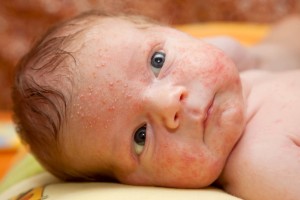Introduction
Similar to skin moles (of which there are hundreds of different histological types) skin rashes are difficult to diagnose for the layperson.
On the other hand they are often easy to recognize for the general practitioner or even more so for the dermatologist. The more rashes a physician has diagnosed, the more accurate he/she becomes and the easier it is to diagnose.
There are eczema, contact dermatitis, tinea infection, dermatitis herpetiformis, impetigo, childhood skin rashes associated with infectious disease to name but a few. As some skin rashes are harmless and others are the first sign of a serious impending illness such as meningitis or typhoid fever, it is important to seek the advice of a physician right away to know what the skin rash means.
Some skin rashes and their causes
(for links see “Related Topics” below)
________________________________________________________________________
Bacterial skin rash: meningitis, typhoid fever, Lyme disease, and a few others
childhood skin rashes (see below) : measles, rubella, chickenpox, diphtheria and others
contact dermatitis : from contact with chemicals, poison ivy, hand soap (hand excema)
dermatomyositis : a form of rheumatological disease
eczema : dry, itchy skin (many forms of it)
atopic dermatitis: a special form of eczema that runs in families, sometimes has exacerbations in winter months
fungal infections : caused by various fungi
lupus : SLE is a rheumatological disease
mononucleosis : Epstein Barr virus produces rash, associated with sluggishness, tonsillitis and lymph gland swelling
syphilis (secondary) : typical skin rash in the second stage
urticarial rash : allergic skin rash (often food allergy) with release of histamine into the skin
________________________________________________________________________
This way the proper steps can be undertaken to prevent disastrous outcomes. Often a condition can be contained, if recognized early and treated right away with the appropriate treatment.
Common Childhood Rashes
During childhood it is common to develop skin rashes from time to time, particularly in association with viral infections (=viral exanthema). The appearance of the rash can tell the physician what the underlying diagnosis is, particularly when this is taken together with the history and other clinical clues and tests. Apart from infections there can be baby rashes of the newborn, but also eczema in the first few years of life. A special form with possible inheritance is atopic dermatitis. In 2014 there have been publications that show that the use of emollient creams daily and at least 1000 IU of vitamin D3 will significantly improve this condition.
Below there is a list of common rashes in children with explanations of some of the important features associated with these rashes.
Common rashes in children
___________________________________________________________________
measles : high fever, viral skin rash, cough, Koplik spots inside the cheek are typical
rubella (thanks to http://www.medicinenet.com/ for image): mild rash, contagious and devastating for pregnant women
chickenpox (=varicella) : same virus as shingles; pustule, then ulcer; can cause encephalitits; vaccine available
5th disease (=erythema subitum) : high fever, which goes away when rash with pinsize lesions appears
diphtheria : serious tonsillitis with rash and delayed heart valve problems
___________________________________________________________________
However, the physician must always include other skin infections that may look similar into the differential diagnosis: they may look similar, but have a different cause. This topic can be so confusing that the family physician sometimes has to refer a patient to a pediatrician or dermatologist for a definite diagnosis of a skin rash to find out whether it is infectious or part of a skin condition. As already mentioned in other chapters of the Net Health Book, skin biopsies have to be taken at times to get a definite diagnosis in more difficult cases.
Here are some links regarding related topics:
NIEHS Allergens & Irritants Guide: http://www.niehs.nih.gov/health/topics/agents/allergens/
Food Allergies and Eczema: http://nationaleczema.org/eczema/types-of-eczema/atopic-dermatitis-2/food-allergies/
References:
1. Habif: Clinical Dermatology, 3rd ed.,1996, Mosby-Year Book, Inc.
2. The Merck Manual, 7th edition, by M. H. Beers et al., Whitehouse Station, N.J., 1999. Chapter 117.
3. Cotran: Robbins Pathologic Basis of Disease, 6th ed.,1999, W. B. Saunders Company
4. Noble: Textbook of Primary Care Medicine, 3rd ed., 2001, Mosby, Inc.
5. Rakel: Conn’s Current Therapy 2001, 53rd ed., 2001, W. B. Saunders Company
6. Goroll: Primary Care Medicine, 4th ed., 2000, Lippincott Williams & Wilkins
7. Richard J. Lewis, M.D. at the 42nd Annual St. Paul’s Hosp. CME Conf., Nov.1996, Vancouver/BC
8. Jerry Shapiro, Prof. Dermatol., UBC, at 45th Annual St. Paul’s Hosp. CME Conf., Nov.1999, Vancouver/BC
9. D Seager Int J Cosmet Surg Vol 6, No. 1, 1998: 27-31.
10. Townsend: Sabiston Textbook of Surgery, 16th ed.,2000, W. B. Saunders Company
11. Ferri: Ferri’s Clinical Advisor: Instant Diagnosis and Treatment, 2004 ed., Copyright © 2004 Mosby, Inc.
12. Rakel: Conn’s Current Therapy 2004, 56th ed., Copyright © 2004 Elsevier







